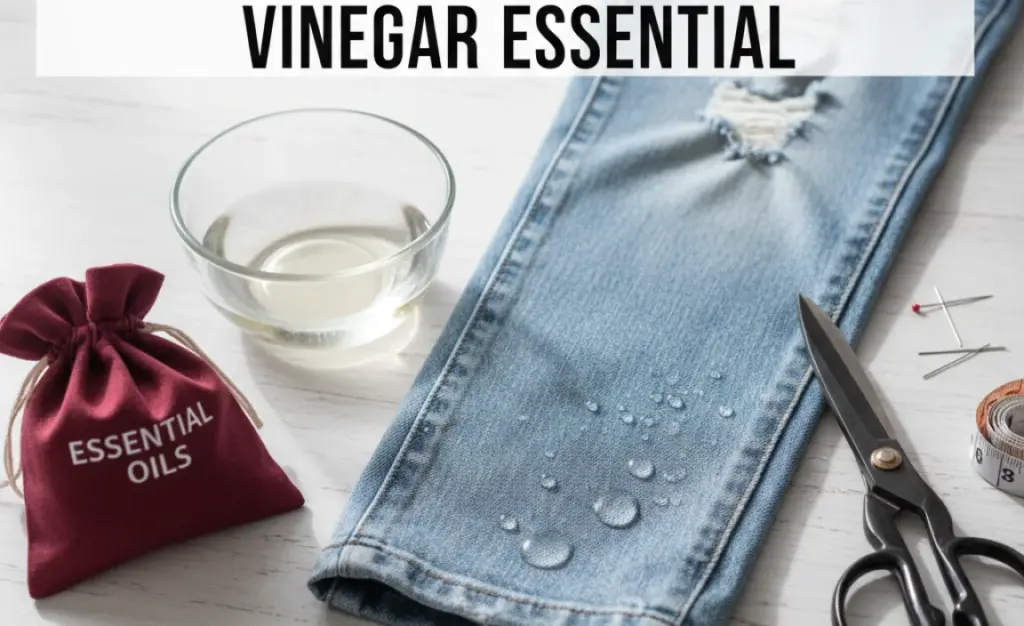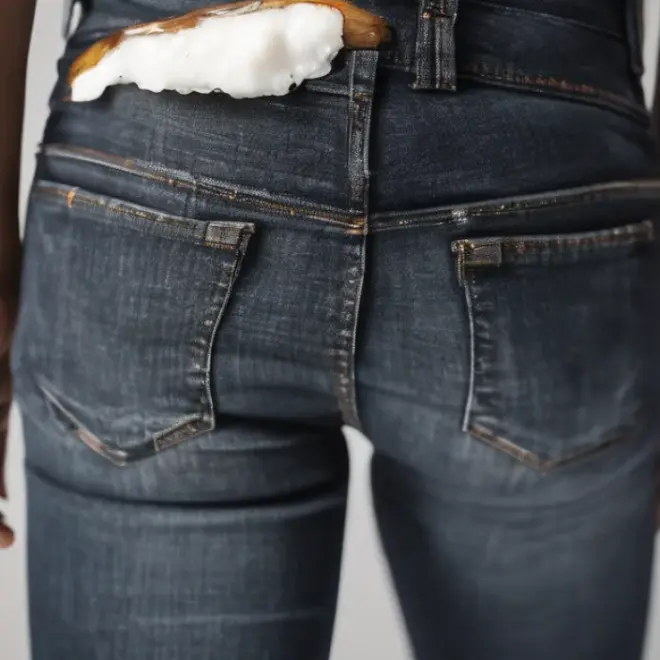Quick Summary: You can easily hem boyfriend jeans using ordinary white vinegar to soften the fabric and make it easier to fold and sew for a neat, lasting finish.
How to Hem Boyfriend Jeans: Vinegar Essential
Dreaming of the perfect boyfriend jeans but they’re a little too long? You’re not alone. Many of us have that favorite pair that’s just a touch too baggy or dragging on the floor, ruining the relaxed vibe. It can be frustrating when your go-to denim doesn’t fit quite right. Don’t worry, giving your jeans a custom hem is simpler than you think, and with a little help from a common household item – white vinegar – you can achieve a professional-looking result right at home. We’ll walk you through each step, making it easy and stress-free.
Why Use Vinegar to Hem Jeans?
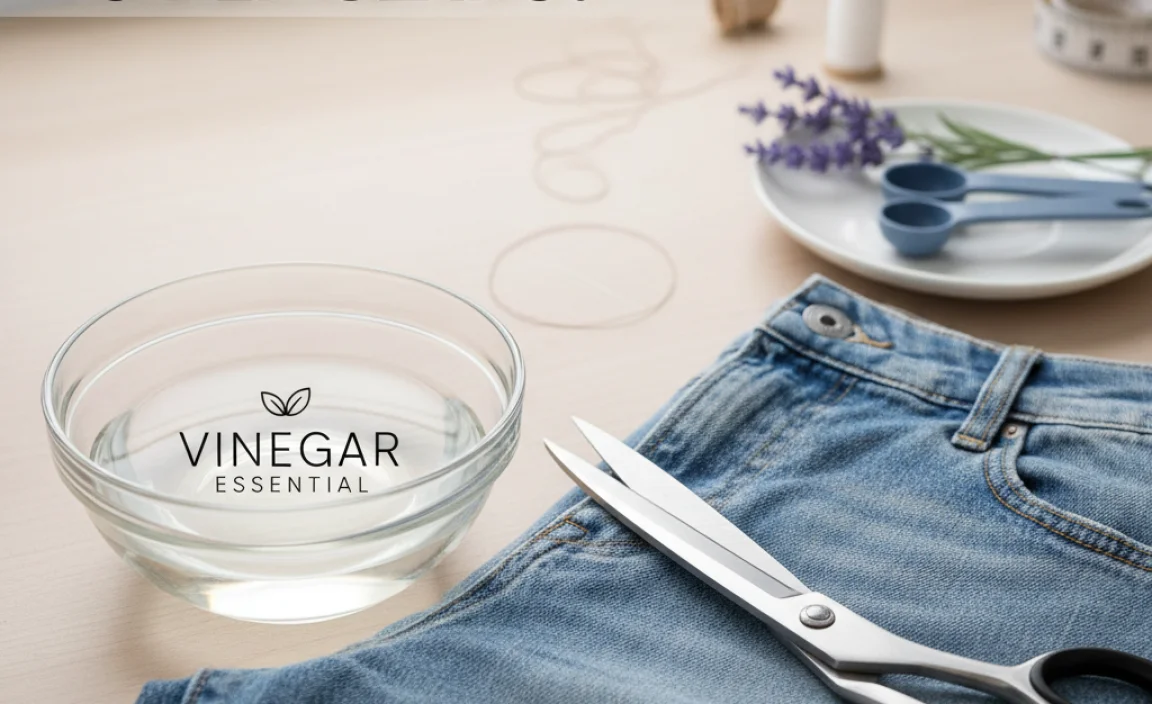
You might be wondering about the vinegar. It might sound unusual, but white vinegar is a fantastic secret weapon for hemming denim. Why? Because it helps to relax the stiff fibers in cotton-rich fabrics like jeans, making them softer and more pliable. This makes folding the hem crisper and sewing through the fabric much easier, preventing skipped stitches and bunching. It also helps set the fold and makes the fabric less likely to spring back, ensuring a cleaner, more durable hem. Plus, it washes out completely, leaving no scent behind.
What You’ll Need

Gathering the right tools is key to a smooth hemming process. Here’s what you’ll want to have on hand:
- Your boyfriend jeans
- White vinegar
- A spray bottle
- Measuring tape or ruler
- Fabric scissors or a rotary cutter and mat
- Fabric chalk or a disappearing ink pen
- Straight pins
- Sewing machine (recommended for speed and durability) or a needle and matching thread
- Iron and ironing board
Step-by-Step Guide to Hemming Boyfriend Jeans with Vinegar
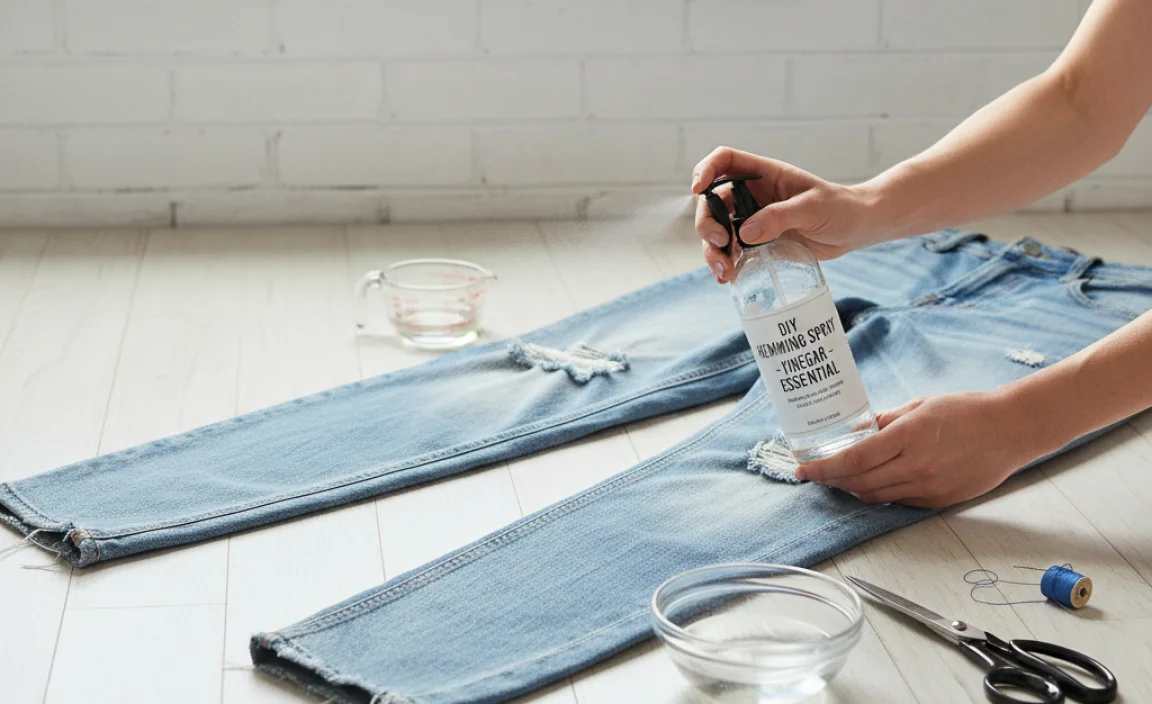
Let’s get started. Follow these steps for a perfect hem:
Step 1: Prepare the Jeans and Your Workspace
First, ensure your jeans are clean and dry. Lay them flat on a clean surface. If you plan to use a lot of vinegar, it’s a good idea to protect your work surface with an old towel or newspaper. Ensure your sewing machine is threaded with a needle suitable for denim and that you have matching thread.
Step 2: Measure and Mark the Desired Length
Put on your boyfriend jeans to determine the length you want. A slightly cropped, ankle-grazing hem often looks great with this style. Mark where you want the bottom of the hem to fall. You can use a fabric chalk or a disappearing ink pen for this. Then, take them off and lay them flat again. Measure from the marked point down to the current hem. This is how much fabric you’ll need to fold up.
For a standard double-fold hem, which is neat and durable, you’ll typically want to add about 1.5 to 2 inches to your desired length for the fold. So, if you want your jeans to end at your ankle bone, measure to that point, then add another 1.5 to 2 inches below that mark. This extra fabric will form your new hem allowance. Mark this new, lower line clearly on both legs. It’s crucial to get this right, as you can’t add fabric back once it’s cut.
Step 3: Cut Off Excess Fabric (If Necessary)
If your jeans are significantly too long, you might want to trim off the excess fabric below your cut line. However, for boyfriend jeans, often the original hem is left intact and then folded up and attached over the original hem. If you’re aiming for a more significant length reduction and want a clean, new hem, cut off any excess fabric below your marked fold line. Remember the adage: measure twice, cut once. Use sharp fabric scissors for a clean cut.
Step 4: Apply the Vinegar Solution
This is where the magic happens. Mix equal parts white vinegar and water in your spray bottle. Lightly spray the area of the jeans where you plan to fold the hem. You want the fabric to be damp, but not soaking wet. Focus on the area that will become the new hem and the section you’ll be folding up.
Let the vinegar solution sit on the fabric for about 10-15 minutes. You’ll notice the denim becoming a bit softer and more relaxed. This brief treatment is enough to make a noticeable difference in how the fabric behaves.
Always use distilled white vinegar. It’s inexpensive and effective. Avoid colored vinegars, as they could potentially stain your denim.
Step 5: Iron and Fold the Hem
Once the vinegar has had a chance to work, press the fabric with your iron. This will help set the softened fibers. Next, carefully fold the bottom of the jeans up to your marked line from Step 2. Make the fold as crisp and even as possible. Press firmly with the iron to create a sharp crease.
Now, fold it up one more time. The raw edge of the denim should now be tucked inside this second fold, resting just above your initial marked line. This creates a clean, double-folded hem that hides the raw edge, preventing fraying and giving a professional finish. Press this second fold very firmly with the iron. The vinegar’s action should make this second fold lie flatter and hold its shape better than it would without the treatment.
Step 6: Pin the Hem in Place
Secure your folded hem with straight pins. Place pins along the folded edge, about every 2-3 inches, ensuring they go through all layers of fabric. This keeps the hem perfectly in place while you sew. Make sure the pins are perpendicular to the edge of the hem, making them easier to remove as you sew.
Step 7: Sew the Hem
This is the final step to securing your new hem. You have two main options:
Option A: Using a Sewing Machine
This is the quickest and most durable method. Set your sewing machine to a straight stitch. Use a denim needle if you have one, as they are designed to go through thicker fabrics. Sew along the top edge of the folded hem. Try to keep your stitching as straight and consistent as possible. Sew around the entire circumference of the leg.
For an authentic look, you can try to match the original stitching color and width of your existing hem. Go slowly, especially as you approach the seams and thicker areas of the jeans. You can reinforce the stitch by sewing over it one more time in the same path once you’ve completed the first round.
Option B: Hand-Sewing the Hem
If you don’t have a sewing machine, you can hand-sew the hem. Use a strong needle and a thread that matches your jeans. A backstitch is a good choice for durability. It will create a strong, secure seam that resembles machine stitching. Alternatively, a whipstitch can also work, though it might be slightly less durable and visible.
Take small, even stitches about 1/8 to 1/4 inch from the top folded edge. Aim for consistent tension so the hem doesn’t pucker. Hand-sewing takes more time, but it’s perfectly achievable and can result in a beautiful finish.
Step 8: Final Touches
Once you’ve sewn the hem, remove all the pins. Gently press the hem again with your iron to ensure everything is flat and neat. Inspect your work. Trim any stray threads. If you used chalk or a disappearing ink pen, ensure all markings are gone (a damp cloth can help with some pens). Your boyfriend jeans are now perfectly hemmed!
Tips for Different Denim Types
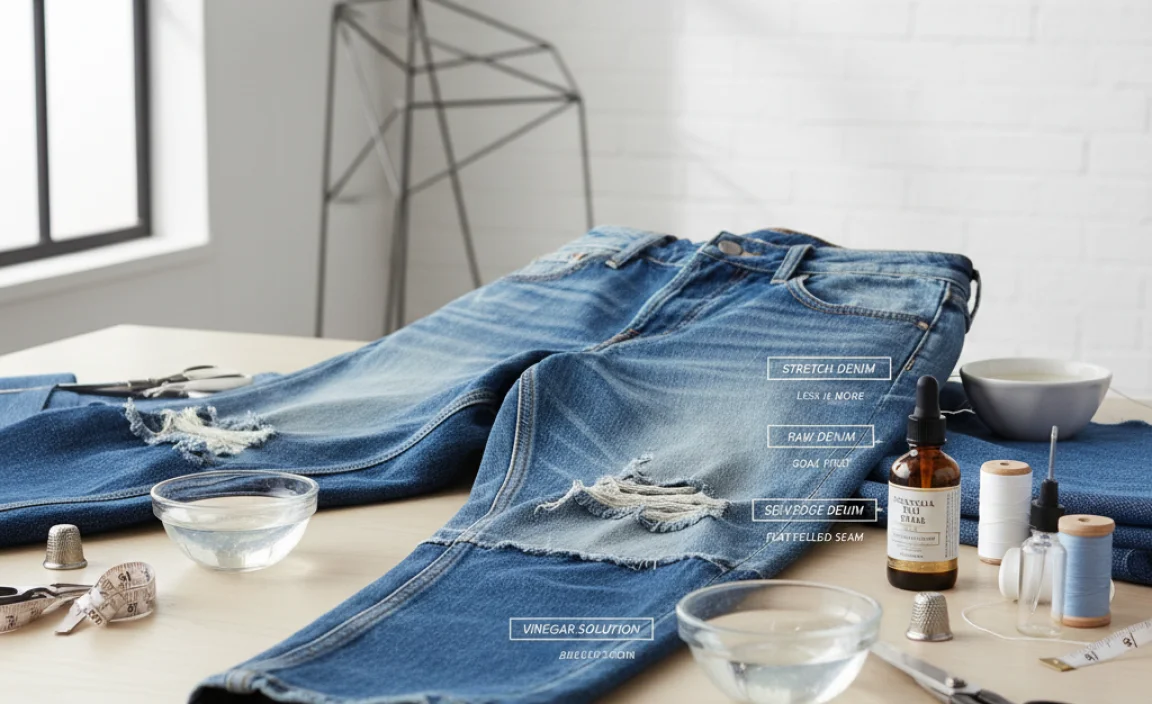
Boyfriend jeans often come in various denim weights and washes. Consider these points:
- Stretch Denim: Denim with a small percentage of elastane (like 1-3%) can be a bit trickier. The elasticity might try to pull the hem back. The vinegar treatment helps, but be sure to pin generously and sew with moderate tension to avoid stretching the fabric as you sew.
- Raw Denim: If your boyfriend jeans are raw denim and you want them to stay stiff, you might want to skip the vinegar. However, even raw denim benefits from a clean hem. You might use a starch spray instead of vinegar to achieve crispness.
- Heavyweight Denim: For very thick denim, a denim needle and possibly a walking foot on your sewing machine can be invaluable. The vinegar will still help soften the fibers, making it easier to guide through the machine.
Common Adjustments for Boyfriend Jeans
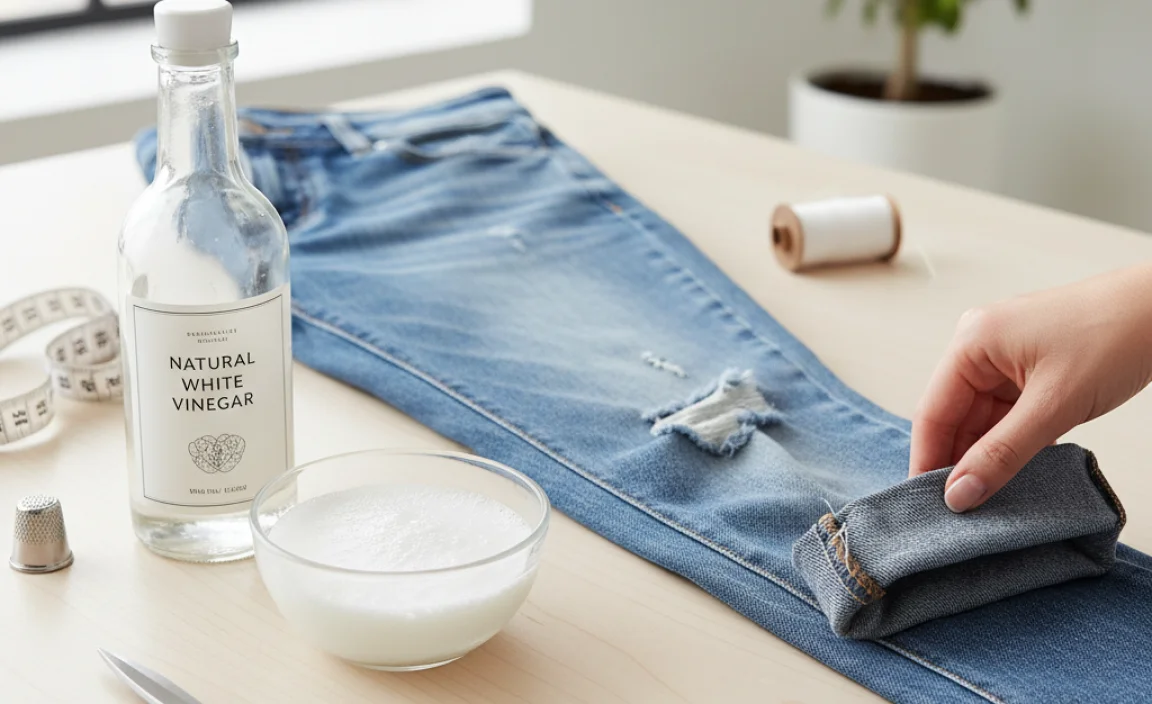
Boyfriend jeans are meant to have a relaxed fit, so hemming them can adjust the overall look. Here are a few common approaches:
Cuffed Hem
This is the most common way to handle boyfriend jeans that are a bit too long. Instead of cutting, you simply cuff them up. You still want them to end at a flattering length when cuffed, so hemming them to that desired length, as described above, provides a neat and permanent cuff.
Cropped Hem
This style involves shortening the jeans to sit above the ankle. You can create a clean, sewn hem or leave the edges with a raw, frayed finish for a more casual look. If going for frayed, ensure you wash the jeans after hemming to encourage fraying and remove any sewing threads that might unravel.
Full Length Adjustment
Even if you love the boyfriend silhouette, sometimes the length is just wrong – too long at the inseam or dragging. The steps outlined above create a standard hem that can be adjusted to any desired length, transforming the fit without altering the intended relaxed style.
Sewing Machine Settings for Denim
Getting your sewing machine ready for denim is important. Here’s a quick guide:
| Machine Setting | Recommendation for Denim | Why |
|---|---|---|
| Needle Type | Denim/Jeans Needle (size 90/14 or 100/16) | Sharp and strong to pierce through thick layers without breaking. |
| Thread Type | Heavy-duty polyester or cotton thread | More durable to withstand the stress on denim seams. |
| Stitch Length | 2.5 – 3.0 mm | A slightly longer stitch provides strength and prevents the fabric from tearing under tension. |
| Tension | Usually standard, but test on a scrap. May need slight adjustment (often slightly lower for thicker fabrics). | To ensure stitches aren’t too tight (causing puckering) or too loose. |
| Presser Foot | Standard or Walking Foot (for even feeding) | A walking foot helps feed multiple layers of denim evenly, preventing skipped stitches. |
It’s always a good idea to test your settings on a scrap piece of denim from an old garment or the hem allowance you cut off. This helps you dial in the perfect stitch before working on your visible hem.
Pros and Cons of Using Vinegar for Hemming
Like any method, there are advantages and disadvantages:
Pros:
- Softens Fabric: Makes denim easier to fold, press, and sew.
- Reduces Stiffness: Prevents the hem from springing back.
- Inexpensive: White vinegar is a common, low-cost household item.
- Improves Crispness: Helps create sharper creases for a neater fold.
- Washable: The vinegar scent disappears completely after washing.
Cons:
- Can Stain (Rarely): While unlikely with white vinegar, very dark or delicate fabrics could theoretically be affected. Always test first if unsure.
- Requires Dampening: You need to work with slightly damp fabric, which might not be ideal for all sewing environments.
- Additional Step: Adds a small step to the hemming process.
Frequently Asked Questions
Q1: Will the vinegar damage my jeans?
A1: No, distilled white vinegar is safe for cotton and denim. It’s a mild acid that helps relax fibers and evaporates without leaving damage or permanent scent once washed.
Q2: How much vinegar should I use?
A2: A 50/50 mixture of white vinegar and water, lightly sprayed on the fabric until damp, is usually sufficient. You don’t want to soak the jeans.
Q3: Can I use apple cider vinegar instead of white vinegar?
A3: It’s best to stick with distilled white vinegar. Apple cider vinegar might leave a slight color tint on lighter denim.
Q4: How long do I need to wait after applying the vinegar?
A4: Letting the vinegar solution sit for about 10-15 minutes is usually enough time for it to work on softening the fabric fibers.
Q5: What if I don’t have a sewing machine?
A5: You can absolutely hand-sew the hem! Use a strong needle, matching thread, and a durable stitch like a backstitch for the best results.
Q6: Can this method be used for other types of pants?
A6: Yes, this vinegar trick can be helpful for hemming other cotton-based trousers or even curtains if the fabric is a bit stiff and hard to fold neatly.
Q7: How do I make sure the hem is even on both legs?
A7: The best way is to measure while wearing the jeans to get your desired length on one leg, mark it, then lay them flat and measure the distance from your mark to the original hem. Use that measurement on the second leg. You can then use a ruler or measuring tape to ensure the folded hem itself is the same width on both legs.
Conclusion
Hemming your boyfriend jeans doesn’t have to be a daunting task. By gathering a few simple tools and utilizing the power of white vinegar, you can easily achieve a custom fit that looks and feels great. This method not only makes the process smoother but also ensures a neat, lasting hem that will give your favorite jeans a new lease on life. Remember to take your time, measure carefully, and enjoy the satisfaction of a DIY project done right. Follow these steps, and soon you’ll be rocking your perfectly hemmed boyfriend jeans.


